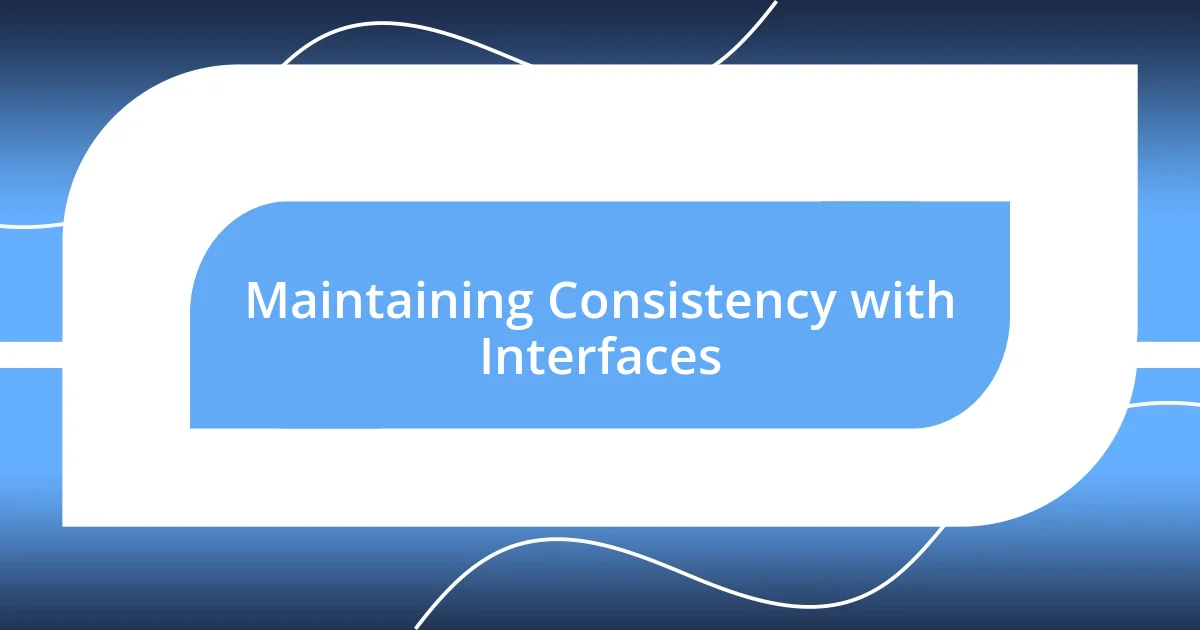Key takeaways:
- Transitioning to TypeScript significantly improved code readability through clear naming conventions and structured types, akin to navigating an organized library.
- Type annotations enhance clarity, serve as self-documentation, reduce errors, and improve team collaboration by creating a shared language.
- Maintaining consistency with interfaces fosters communication, minimizes manual checks, and allows for graceful code evolution, thereby enhancing long-term maintainability.

Understanding Code Readability
Code readability is like the lens through which we view and understand our work, isn’t it? I remember the first time I took a long look at a disorganized codebase; I felt like I was staring at a tangled ball of yarn. It wasn’t just the confusion—it was a sense of frustration that made me question not just the code, but also my own skills.
When I shifted to TypeScript, something clicked. I found that clear naming conventions and structured types made everything more intuitive. It’s almost like when you enter a well-organized library compared to a chaotic storage room; you can quickly locate what you need and dive into your tasks without unnecessary delays. I’ve learned that small adjustments in consistency can lead to profound impacts on how easily we understand code.
Moreover, I often ponder: how much easier would debugging be if we treated our code with the same care as we do our written communication? I’ve realized how vital it is to write code that speaks to others and is clear enough for future me to grasp seamlessly. I’ve found that investing time in readability saves countless hours later, offering clarity not just for the coder but for the whole team.

Improving Readability with Type Annotations
Type annotations in TypeScript have profoundly changed how I perceive and write code. Initially, I was skeptical about how adding type information could possibly enhance readability. However, as I started incorporating type annotations, it was like turning on the lights in a dim room—I could see everything clearly. Suddenly, the roles of each variable were defined, and potential bugs became more obvious, reducing the time I spent puzzling over unexpected behaviors.
Here’s what I’ve found about the advantages of using type annotations:
- Clarity: Knowing the data types up front provides instant context, making it easier to follow the logic of the code.
- Self-Documentation: Types serve as documentation, meaning new team members can get up to speed quickly without needing extensive explanations.
- Error Reduction: By specifying types, I reduce the likelihood of runtime errors, allowing me to focus on solving problems rather than chasing bugs.
- Enhanced Collaboration: When working in teams, consistent type annotations create a shared language that improves communication and understanding across the board.
Reflecting on my journey, I’ve come to appreciate how these annotations transform code into readable narratives rather than cryptic puzzles.

Maintaining Consistency with Interfaces
Maintaining consistency with interfaces in TypeScript has been a game changer for my development process. When I first started using interfaces, I didn’t quite grasp their impact on consistency. But over time, I realized that defining clear interfaces for my objects created a shared agreement about how those objects should look and behave. One day, while working on a collaborative project, I saw how simply adhering to an interface streamlined our discussions and reduced confusion about data structures. That experience reinforced how powerful a well-structured interface can be in maintaining clarity across the entire team.
As I’ve worked on various projects, I’ve found that interfaces serve as a guiding light for my coding practices. For instance, instead of manually checking if every object adheres to certain requirements, I rely on interfaces to enforce those standards automatically. This not only minimizes errors but also invites a sense of trust in coded solutions. I remember a moment when a colleague updated an important interface without informing me, and it nearly derailed our functionality. It was a wake-up call about the importance of communication and getting on the same page regarding interfaces. Now, I always encourage my peers to think of interfaces as contracts that bind us to a level of professionalism and consistency.
Finally, I believe one of the joys of working with TypeScript interfaces is their ability to evolve gracefully. Interfaces can extend and adapt as needed, which allows my code to grow organically without sacrificing that foundational consistency. Just the other day, I was refactoring an old project. It was fascinating to see how the interfaces I defined years ago still held true, guiding new features with a sense of cohesion. This adaptability, coupled with a commitment to consistency, not only improves readability but also enhances long-term maintainability.
| Aspect | Without Interfaces | With Interfaces |
|---|---|---|
| Clarity | Confusion about data structures | Well-defined object structure |
| Communication | Misunderstandings in team | Shared agreement on definitions |
| Error Handling | Manual checks | Automatic enforcement of standards |
| Maintainability | Challenging to update | Graceful evolution of code |

Case Studies on TypeScript Success
In a recent project at work, I had the chance to leverage TypeScript’s union types for an application that needed to handle multiple data formats. I remember looking at my initial code, which was riddled with “if” statements to check the type of each variable. The moment I implemented union types, it felt like discovering a shortcut in a maze. Suddenly, my code was not only cleaner, but the intent behind each variable was crystal clear. This experience highlighted how TypeScript’s ability to define multiple acceptable types can simplify conditions and enhance readability.
Another memorable case occurred while collaborating with a remote team. We had varying coding styles, which inevitably led to confusion during code reviews. However, when we collectively decided to adopt TypeScript, the transformation was remarkable. The use of generics allowed us to define flexible yet type-safe functions. I distinctly recall the relief in our video call discussions later on—no longer did we have to second-guess each other’s logic. Generics broadened our coding conversations and fostered a sense of clarity that we desperately needed; doesn’t it feel good to work in harmony?
Lastly, I want to share my thoughts on leveraging enums in TypeScript. Initially, I used plain string constants, but transitioning to enums was a revelation. Instead of arbitrary strings floating around my code, I created meaningful, descriptive identifiers for status options. During a particularly tricky debugging session, I encountered a value that was out of sync with our expectations. Thanks to the enums, tracing the issue back was seamless. It made me realize how helpful enums are for conveying intent—every time I encountered that status, it felt like re-reading a familiar chapter instead of deciphering a cryptic message. This shift not only improved code readability but also made me appreciate how conveying meaning through structure can reduce frustration and enhance collaboration.












